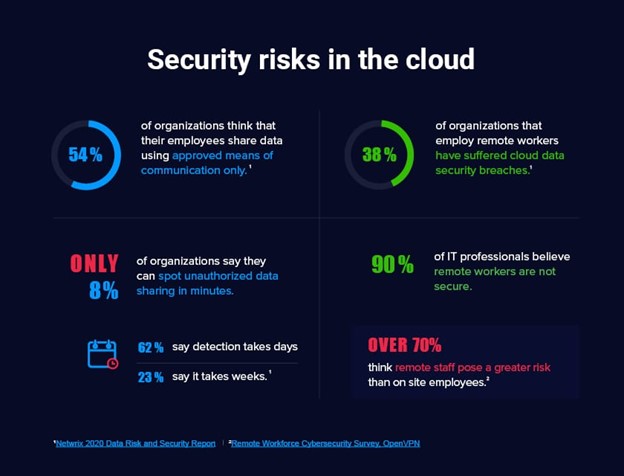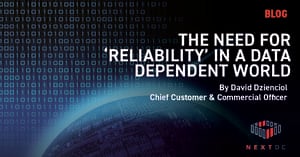By Claire Sangster, State Manager, Western Australia
There are five key areas of data risk every business should be continually extending their knowledge about to build digital resilience in a data-led economy.
As digital transformation evolves, adapting to requirements for uninterrupted services continues to change the dynamic of risk profiles.
In the midst of major health, safety, climate and competitive challenges, data security and the protection of corporate data is more critical than ever. Let’s explore the top five data security risks for businesses and enterprises in 2022.

1. Data unavailability is a major business risk
The days when some downtime was classified as acceptable for critical systems are behind us. Industry 4.0, aka the data economy, is underpinned by immediacy – where users and customers expect instant access to information, applications and services, or they’re gone.
Nobody wants to be the next financial transaction platform that fails during peak Christmas shopping. No business can afford to operate with an unstable online presence or business process platform. With the whole economy being re-engineered towards complete reliance on digital systems, eliminating downtime equals mitigating risk.
Knowing your critical environments have complete protection against standard risks like fire, extreme weather and power or cooling failure are major things – but the human element can’t afford to be overlooked.
Digital growth across the economy has upset the supply and demand scales for skilled workers. Ensuring you have the expertise at hand to optimise ROI, proactively manage complex operational environments and have established best practice standards for incident response and resolution is equally as challenging.
Availability is a lot less risky when you can put faith in critical infrastructure that is designed, built and operated for 100% uptime and facilitates seamless redundancy, back-up and disaster recovery strategy.
2. Data security and protection from cyber threats
Data is gold. We know cyber threats are accelerating in sophistication and frequency; what is less understood are the challenges of keeping up with legislation and compliance obligations. Under evolving standards, mandates and frameworks, physical and cyber security disciplines now converge to form a holistic security posture.
Protection from phishing, malware and ransomware attacks are not the only risks around data management. New mandates from the Government about where Australian data is hosted and how it’s shared adds layers of data sovereignty discipline and potential sanctions to the equation.
Every business working with Government data will soon have to ensure their critical infrastructure is hosted within facilities DTA Certified Strategic; meaning they’re verified as meeting strict standards for physical security and sovereign ecosystems.
3. Data security is a matter of compliance
Regulatory mandates around data, security, privacy, retention and sovereignty are constantly evolving and continue to represent huge risk for businesses. For example, Federal legislation is currently being developed to reclassify data centres as ‘critical infrastructure’ bringing additional scrutiny and significant compliance obligations to how they are regulated.
Every industry has its own unique compliance requirements which all come with risks magnified in the digital world. Often governed by complex frameworks requiring significant skills and capital investment, compliance programs divert focus from other areas of the business which provide greater returns.
Where digital infrastructure is concerned, reducing non-compliance risks and eliminating the headaches associated with managing audit processes, metrics and reporting, frees resources to focus on improving core competencies and growth opportunities.
4. Hybrid IT can provide protection from network failure
Today’s digital enterprises are only as good as their interconnection strategies. Risks associated with network failure are rising. According to 2022 research from Uptime Institute, network-related outages (29%) have replaced power (24%) as the biggest cause of serious IT downtime.
Hybrid IT architecture is interconnected by a myriad of network services, any break in the web can impact everything. Positioning yourself to take full advantage of productivity gains and cost optimisations emerging from megatrends such as 5G, IoT, AI and VR is dependent upon resilient network architectures and services that are visible, flexible and agile to provision.
Meanwhile, as digital processes cement themselves at the foundations of growth, network traffic risks being gridlocked. Bandwidth, latency and jitter pose enormous risk to effective utilisation of hybridised architecture where data is shared multiple times across multiple physical and virtual platforms and environments.
Slow is the new downtime in the digital economy. Every fraction of a second lost from screen loads or datasets moving from Point A to B, impacts essential metrics governing productivity or customer experience.
Proximity to cloud availability zones and digital services; utilising a combination of fixed and pay-as-you-go interconnection services, introduces elemental performance optimisation, cost efficiency and risk mitigation levers.
5. Competitive disruption
Arguably, the greatest business risk is being blind-sided by innovative competitors or seeing international cloud native companies leveraging deep pockets, low overheads and large marketing budgets to undermine your market share.
At present, the financial services sector is being flooded by international cloud-native providers with innovative products, clever marketing and lean business models driven by automation and investment in seamless customer experience. Similarly, internet services and domain hosting companies are under siege from global raiders looking to leverage scale and remote management of everything from service delivery to support as competitive advantage. Every sector is in the same boat. The future of commerce is global and automated so knowing how to level the digital playing field through innovation and growth agendas will ensure you’re not left on the bench for big future games.
Australia is a safe-haven in Asia-Pacific for overseas expansion. World-class digital infrastructure, high-speed submarine cables connecting Asia and the world directly into Perth and Australia is the perfect complement to the geo-political stability that can turn the odds in your favour.
Know the jeweller
Arguably, the greatest business risk is being blind-sided by innovative competitors or seeing international cloud native companies leveraging deep pockets, low overheads and large marketing budgets to undermine your market share.
Another quote from Warren Buffet reads: “If you don’t know the jewellery, know the jeweller”. This is particularly apt when it comes to digital risk. The above five risk elements are all core conversations to have with technology providers.
When you don’t understand all the implications to business risk from downtime, security, network outages, compliance and competitive disruption, it’s best to partner with specialists who do.
Reach out to NEXTDC to better understand the risks that could drop a spanner into your business’ digital transformation mechanics and to discuss how to mitigate these dangers.


